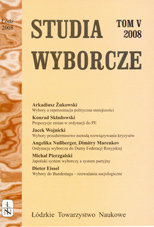Wybory do Bundestagu. Uwagi na temat przemian politycznych i czynników warunkujących wyniki głosowań
ELECTIONS TO THE GERMAN BUNDESTAG. SOME CONSIDERATIONS ABOUT CHANGES AND INFLUENCING FACTORS
Author(s): Dieter EißelSubject(s): Politics / Political Sciences
Published by: Łódzkie Towarzystwo Naukowe
Summary/Abstract: The article presents the elections to Bundestag and its influence on the shape of political scene in Germany in past five decades. The electoral system in this country is a mixed one, which means that it implements both the elements of majority and proportional scheme. Such construction seems to be favourable for large parties and the outcomes of the elections cast in Federal Republic of Germany during the post-war period can give the empirical evidence for above-stated thesis. In general, since the first elections after the war, the political parties in West Germany have shown an increasing tendency toward consolidation, but on the other hand, the proportional element of the electoral system necessitated formation of coalition governments. Thus, until the beginning of 1980s the parliament was dominated by Conservatives (CDU/CSU) and Social Democrats (SPD) with smaller FPD as tipping the balance. Then, the three party system has transformed into five party one, with the Greens as the fourth and the Left as the fifth important actor. The author shows and comments on the major socio-economic and political factors that influenced the formulation of party programmes and long-term domination of CDU/CSU in West Germany, as well as the reasons for changes on political scene before and after the reunification of the country. The last part of the paper is focused on the presentation of the influence of structural factors on attitudes of the electorate in Germany. The electoral behaviours and party identifications, which are strong among the majority of Germans, are still correlated with socio-demographic and economic characteristics such as age, gender, confession or class position.
Journal: Studia Wyborcze
- Issue Year: 2008
- Issue No: 05
- Page Range: 99-118
- Page Count: 20
- Language: Polish

